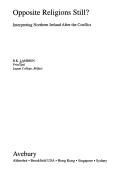It is natural that school children should want to know what fighting in Northern Ireland has been about. This text reports on the Opposite Religions Project 1988-92, and addresses the issue of how Northern Ireland should be interpreted after the conflict. So deep is the divide between Catholics and Protestants that they refer to each other as if they belong to "opposite religions". Most schoolchildren in Northern Ireland think that the fighting has been about religion. Adults, however, do not agree. After the ceasefires, there is still no consensus on the nature of the conflict, rather a "meta-conflict about the conflict". This text is concerned with how schoolchildren in Northern Ireland perceive their own and each other's religious traditions, how they perceive the inter-connection of religion and politics and how they perceive "the other side". Building mainly on the work of Whyte, Hickey and Bruce, it argues that a consensus about the interpretation of the conflict is emerging.
Using Boyle and Hadden's work on "the choice" between sharing and separation, it develops a theory of "conflict intractability" based on the idea of "choice modulation" and the "opposite religions" question. Further, it argues that an important part of the peace-building process after the conflict will be the mediating of a consensus interpretation to as wide an audience as possible. Finally, it addresses the question of how this might best be done through a Centre for Religion in Ireland.
- ISBN10 185972163X
- ISBN13 9781859721636
- Publish Date 4 April 1996
- Publish Status Out of Print
- Out of Print 30 July 2009
- Publish Country GB
- Publisher Taylor & Francis Ltd
- Imprint Avebury
- Format Hardcover
- Pages 222
- Language English
